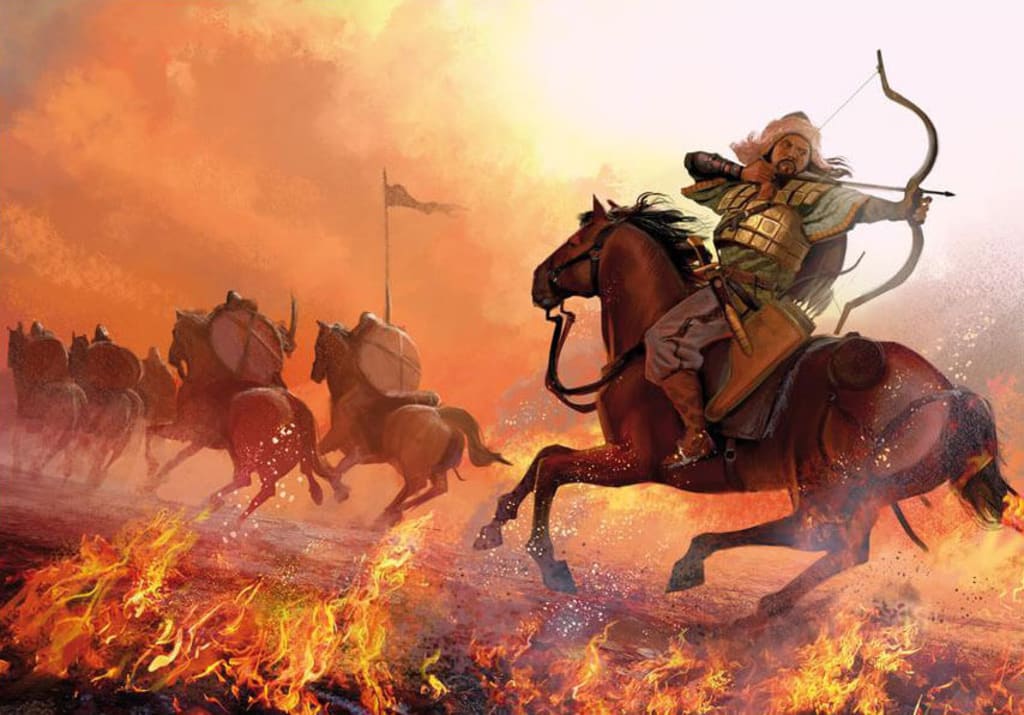Content warning
This story may contain sensitive material or discuss topics that some readers may find distressing. Reader discretion is advised. The views and opinions expressed in this story are those of the author and do not necessarily reflect the official policy or position of Vocal.

It was the largest contiguous land empire in history—
stretching from Korea to Ukraine and from Siberia to southern China,
and was forged on the open plains.
In the 12th century CE, before the Mongol Empire formed,
the East Asian steppe was home to scattered groups of Mongol
and Turkic pastoral nomads led by Khans.
The people herded sheep, cattle, yaks, and camels.
They lived in felt tents and moved between summer and winter campsites.
Nomadic women held significant authority,
managing these migrations, many of the flocks, and trade.
Meanwhile, men specialized in mounted warfare.
These nomadic groups often fought each other.
That was to change under Temujin, who was born into an aristocratic Mongol family.
Despite losing his father at an early age and growing up in poverty,
he quickly rose to power by forging strategic alliances with other leaders.
Unlike those khans, Temujin promoted soldiers based on merit
and distributed spoils evenly among them.
His most brilliant move was to scatter the nomads he conquered
among his own soldiers so they couldn't join together against him.
These innovations made him unstoppable,
and by 1206, he had united the people of the felt-walled tents
and become Chinggis Khan.
The Mongols were shamanists,
believing that the spirits of nature and their ancestors
inhabited the world around them.
Overall arched the Sky god Tenggeri.
Chinggis Khan believed that Tenggeri wanted him to conquer the entire world
in his name.
With the nomads of the Mongolian plain united,
this seemed within reach.
Anyone who resisted the Mongols was resisting Tenggeri's will,
and for this insubordination, had to die.
Under Chinggis Khan,
the Mongols first subdued northern China and the eastern Islamic lands.
After his death in 1227,
the Divine Mandate passed to his family or the Golden Lineage.
In the 1230s, Chinggis Khan's sons and daughters
conquered the Turks of Central Asia and the Russian princes,
then destroyed two European armies in 1241.
In the 1250s, the Mongols seized Islamic territory as far as Baghdad,
while in the East their grasp reached southern China by 1279.
Life within the Mongol Empire wasn't just war, pillage, and destruction.
Once the Mongols conquered territory, they left their internal politics alone
and used local administrators to govern for them.
The Mongols let all religions flourish, as long as the leaders prayed for them.
Although they routinely captured artisans, scholars, and engineers,
they appreciated what those specialists could do
and forcibly settled them across Asia to continue their work.
The most valuable produce in the Empire was gold brocade,
which took silk from China, gold from Tibet, and weavers from Baghdad.
Gold brocade clothed the Mongol rulers, covered their horses
, and lined their tents.
The Mongols particularly prized gunpowder technicians from China.
With much of Eurasia politically unified, trade flourished along the Silk Road,
helped by an extensive system of horse messengers and relay posts.
Robust trade continued at sea, especially in blue-and-white porcelain,
which combined white pottery from Mongol China with blue dye from Mongol Iran.
But this was not to last.
Succession to the Great Khan didn't automatically go to the eldest son,
but rather allowed brothers, uncles, and cousins to vie for leadership
with senior widows acting as regents for their sons.
By the 1260s,
Chinggis Khan's grandsons were in a full-blown civil war over inheritance
which fragmented the realm into four separate empires.
In China, Kublai Khan's Yuan Dynasty
is remembered as a golden age of science and culture.
In Iran, the Ilkhanate inaugurated the development
of new monumental architecture and Persian miniature painting.
In Central Asia, the Chagatai Khanate brought forth leaders like Timur
and his descendant Babur, who founded the Mughal Empire in India.
And in Eastern Europe, the Golden Horde ruled for years
until a trading post named Muscovy grew into a major world power.
Even though the Empire lasted only a short while,
the Mongols left a legacy of world- domination that remains unmatched today.
About the Creator
Hamza Bashir
My Name is Hamza Bashir.i am professional artical writter.I have 5+ years experince.
Thank u...
Enjoyed the story? Support the Creator.
Subscribe for free to receive all their stories in your feed. You could also pledge your support or give them a one-off tip, letting them know you appreciate their work.






Comments
There are no comments for this story
Be the first to respond and start the conversation.